Ashish Vaswani
Essential-Web v1.0: 24T tokens of organized web data
Jun 17, 2025Abstract:Data plays the most prominent role in how language models acquire skills and knowledge. The lack of massive, well-organized pre-training datasets results in costly and inaccessible data pipelines. We present Essential-Web v1.0, a 24-trillion-token dataset in which every document is annotated with a twelve-category taxonomy covering topic, format, content complexity, and quality. Taxonomy labels are produced by EAI-Distill-0.5b, a fine-tuned 0.5b-parameter model that achieves an annotator agreement within 3% of Qwen2.5-32B-Instruct. With nothing more than SQL-style filters, we obtain competitive web-curated datasets in math (-8.0% relative to SOTA), web code (+14.3%), STEM (+24.5%) and medical (+8.6%). Essential-Web v1.0 is available on HuggingFace: https://huggingface.co/datasets/EssentialAI/essential-web-v1.0
Practical Efficiency of Muon for Pretraining
May 04, 2025Abstract:We demonstrate that Muon, the simplest instantiation of a second-order optimizer, explicitly expands the Pareto frontier over AdamW on the compute-time tradeoff. We find that Muon is more effective than AdamW in retaining data efficiency at large batch sizes, far beyond the so-called critical batch size, while remaining computationally efficient, thus enabling more economical training. We study the combination of Muon and the maximal update parameterization (muP) for efficient hyperparameter transfer and present a simple telescoping algorithm that accounts for all sources of error in muP while introducing only a modest overhead in resources. We validate our findings through extensive experiments with model sizes up to four billion parameters and ablations on the data distribution and architecture.
Rethinking Reflection in Pre-Training
Apr 05, 2025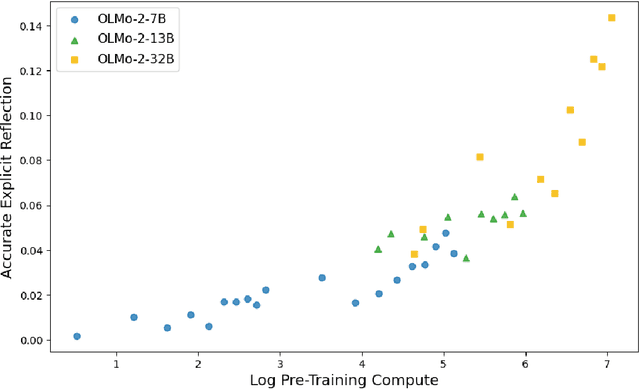

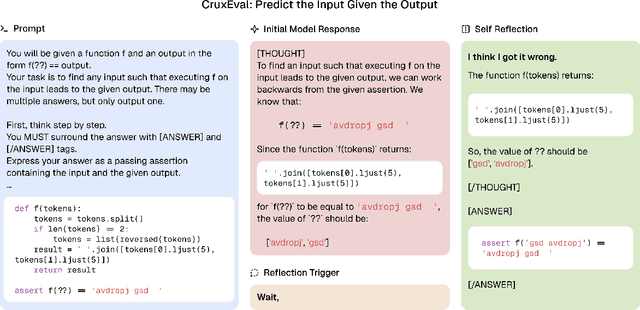

Abstract:A language model's ability to reflect on its own reasoning provides a key advantage for solving complex problems. While most recent research has focused on how this ability develops during reinforcement learning, we show that it actually begins to emerge much earlier - during the model's pre-training. To study this, we introduce deliberate errors into chains-of-thought and test whether the model can still arrive at the correct answer by recognizing and correcting these mistakes. By tracking performance across different stages of pre-training, we observe that this self-correcting ability appears early and improves steadily over time. For instance, an OLMo2-7B model pre-trained on 4 trillion tokens displays self-correction on our six self-reflection tasks.
The Efficiency Misnomer
Oct 25, 2021


Abstract:Model efficiency is a critical aspect of developing and deploying machine learning models. Inference time and latency directly affect the user experience, and some applications have hard requirements. In addition to inference costs, model training also have direct financial and environmental impacts. Although there are numerous well-established metrics (cost indicators) for measuring model efficiency, researchers and practitioners often assume that these metrics are correlated with each other and report only few of them. In this paper, we thoroughly discuss common cost indicators, their advantages and disadvantages, and how they can contradict each other. We demonstrate how incomplete reporting of cost indicators can lead to partial conclusions and a blurred or incomplete picture of the practical considerations of different models. We further present suggestions to improve reporting of efficiency metrics.
Scale Efficiently: Insights from Pre-training and Fine-tuning Transformers
Sep 22, 2021
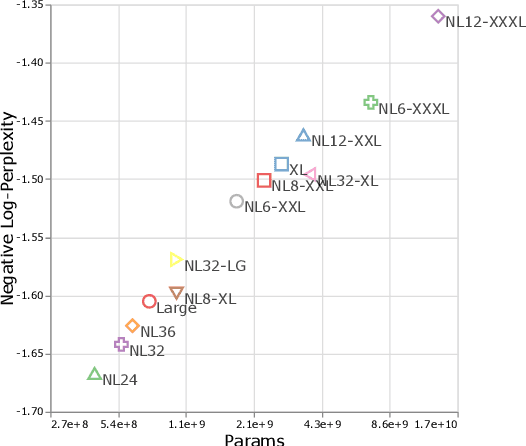
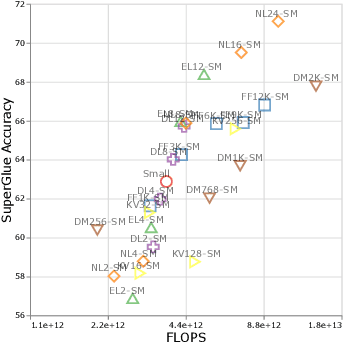

Abstract:There remain many open questions pertaining to the scaling behaviour of Transformer architectures. These scaling decisions and findings can be critical, as training runs often come with an associated computational cost which have both financial and/or environmental impact. The goal of this paper is to present scaling insights from pretraining and finetuning Transformers. While Kaplan et al. presents a comprehensive study of the scaling behaviour of Transformer language models, the scope is only on the upstream (pretraining) loss. Therefore, it is still unclear if these set of findings transfer to downstream task within the context of the pretrain-finetune paradigm. The key findings of this paper are as follows: (1) we show that aside from only the model size, model shape matters for downstream fine-tuning, (2) scaling protocols operate differently at different compute regions, (3) widely adopted T5-base and T5-large sizes are Pareto-inefficient. To this end, we present improved scaling protocols whereby our redesigned models achieve similar downstream fine-tuning quality while having 50\% fewer parameters and training 40\% faster compared to the widely adopted T5-base model. We publicly release over 100 pretrained checkpoints of different T5 configurations to facilitate future research and analysis.
Simple and Efficient ways to Improve REALM
Apr 18, 2021



Abstract:Dense retrieval has been shown to be effective for retrieving relevant documents for Open Domain QA, surpassing popular sparse retrieval methods like BM25. REALM (Guu et al., 2020) is an end-to-end dense retrieval system that relies on MLM based pretraining for improved downstream QA efficiency across multiple datasets. We study the finetuning of REALM on various QA tasks and explore the limits of various hyperparameter and supervision choices. We find that REALM was significantly undertrained when finetuning and simple improvements in the training, supervision, and inference setups can significantly benefit QA results and exceed the performance of other models published post it. Our best model, REALM++, incorporates all the best working findings and achieves significant QA accuracy improvements over baselines (~5.5% absolute accuracy) without any model design changes. Additionally, REALM++ matches the performance of large Open Domain QA models which have 3x more parameters demonstrating the efficiency of the setup.
Scaling Local Self-Attention for Parameter Efficient Visual Backbones
Mar 30, 2021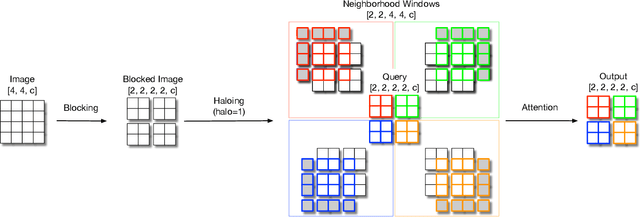


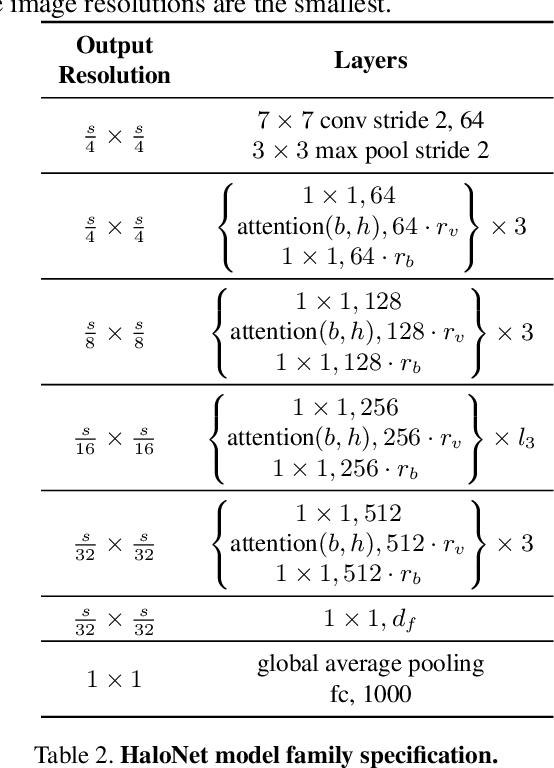
Abstract:Self-attention has the promise of improving computer vision systems due to parameter-independent scaling of receptive fields and content-dependent interactions, in contrast to parameter-dependent scaling and content-independent interactions of convolutions. Self-attention models have recently been shown to have encouraging improvements on accuracy-parameter trade-offs compared to baseline convolutional models such as ResNet-50. In this work, we aim to develop self-attention models that can outperform not just the canonical baseline models, but even the high-performing convolutional models. We propose two extensions to self-attention that, in conjunction with a more efficient implementation of self-attention, improve the speed, memory usage, and accuracy of these models. We leverage these improvements to develop a new self-attention model family, HaloNets, which reach state-of-the-art accuracies on the parameter-limited setting of the ImageNet classification benchmark. In preliminary transfer learning experiments, we find that HaloNet models outperform much larger models and have better inference performance. On harder tasks such as object detection and instance segmentation, our simple local self-attention and convolutional hybrids show improvements over very strong baselines. These results mark another step in demonstrating the efficacy of self-attention models on settings traditionally dominated by convolutional models.
Bottleneck Transformers for Visual Recognition
Jan 27, 2021



Abstract:We present BoTNet, a conceptually simple yet powerful backbone architecture that incorporates self-attention for multiple computer vision tasks including image classification, object detection and instance segmentation. By just replacing the spatial convolutions with global self-attention in the final three bottleneck blocks of a ResNet and no other changes, our approach improves upon the baselines significantly on instance segmentation and object detection while also reducing the parameters, with minimal overhead in latency. Through the design of BoTNet, we also point out how ResNet bottleneck blocks with self-attention can be viewed as Transformer blocks. Without any bells and whistles, BoTNet achieves 44.4% Mask AP and 49.7% Box AP on the COCO Instance Segmentation benchmark using the Mask R-CNN framework; surpassing the previous best published single model and single scale results of ResNeSt evaluated on the COCO validation set. Finally, we present a simple adaptation of the BoTNet design for image classification, resulting in models that achieve a strong performance of 84.7% top-1 accuracy on the ImageNet benchmark while being up to 2.33x faster in compute time than the popular EfficientNet models on TPU-v3 hardware. We hope our simple and effective approach will serve as a strong baseline for future research in self-attention models for vision.
Efficient Content-Based Sparse Attention with Routing Transformers
Mar 12, 2020



Abstract:Self-attention has recently been adopted for a wide range of sequence modeling problems. Despite its effectiveness, self-attention suffers from quadratic compute and memory requirements with respect to sequence length. Successful approaches to reduce this complexity focused on attending to local sliding windows or a small set of locations independent of content. Our work proposes to learn dynamic sparse attention patterns that avoid allocating computation and memory to attend to content unrelated to the query of interest. This work builds upon two lines of research: it combines the modeling flexibility of prior work on content-based sparse attention with the efficiency gains from approaches based on local, temporal sparse attention. Our model, the Routing Transformer, endows self-attention with a sparse routing module based on online k-means while reducing the overall complexity of attention to $O\left(n^{1.5}d\right)$ from $O\left(n^2d\right)$ for sequence length $n$ and hidden dimension $d$. We show that our model outperforms comparable sparse attention models on language modeling on Wikitext-103 (15.8 vs 18.3 perplexity) as well as on image generation on ImageNet-64 (3.43 vs 3.44 bits/dim) while using fewer self-attention layers.
Stand-Alone Self-Attention in Vision Models
Jun 13, 2019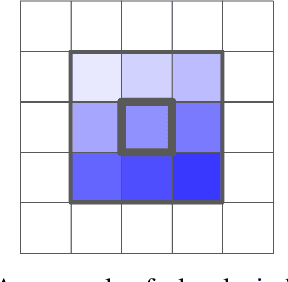

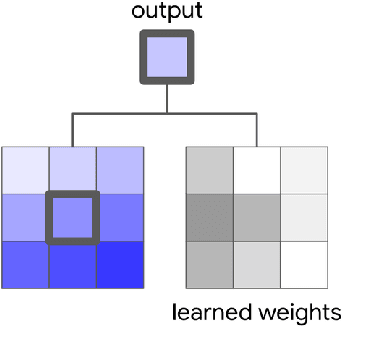

Abstract:Convolutions are a fundamental building block of modern computer vision systems. Recent approaches have argued for going beyond convolutions in order to capture long-range dependencies. These efforts focus on augmenting convolutional models with content-based interactions, such as self-attention and non-local means, to achieve gains on a number of vision tasks. The natural question that arises is whether attention can be a stand-alone primitive for vision models instead of serving as just an augmentation on top of convolutions. In developing and testing a pure self-attention vision model, we verify that self-attention can indeed be an effective stand-alone layer. A simple procedure of replacing all instances of spatial convolutions with a form of self-attention applied to ResNet model produces a fully self-attentional model that outperforms the baseline on ImageNet classification with 12% fewer FLOPS and 29% fewer parameters. On COCO object detection, a pure self-attention model matches the mAP of a baseline RetinaNet while having 39% fewer FLOPS and 34% fewer parameters. Detailed ablation studies demonstrate that self-attention is especially impactful when used in later layers. These results establish that stand-alone self-attention is an important addition to the vision practitioner's toolbox.
 Add to Chrome
Add to Chrome Add to Firefox
Add to Firefox Add to Edge
Add to Edge